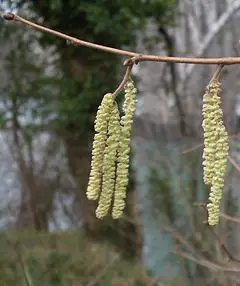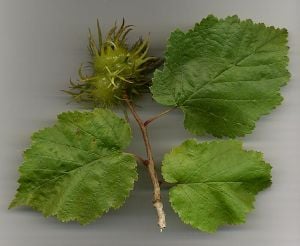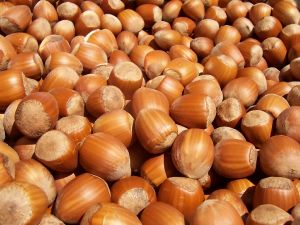Difference between revisions of "Hazel" - New World Encyclopedia
Rick Swarts (talk | contribs) |
Rick Swarts (talk | contribs) |
||
| Line 15: | Line 15: | ||
}} | }} | ||
| − | '''Hazel''' is the common name for any of the large [[shrub]]s and small [[tree]]s comprising the [[flowering plant]] [[genus]] '''''Corylus''''', native to the temperate northern hemisphere and characterized by simple, round [[leaf|leaves]] with double-serrate margins and [[fruit]] in the form of edible [[nut]]s, known as hazelnuts. | + | '''Hazel''' is the common name for any of the large [[shrub]]s and small [[tree]]s comprising the [[flowering plant]] [[genus]] '''''Corylus''''', native to the temperate northern hemisphere and characterized by simple, round [[leaf|leaves]] with double-serrate margins and [[fruit]] in the form of edible [[nut]]s, known as hazelnuts. The nuts are surrounded by a leafy husk. |
Two European species, the filbert, ''Corylus maxima'', and the common hazel, ''Corylus avellana'', are particular well-known as cultivated species for their edible nuts. The term filbert sometimes is used to refer to both hazel trees and commercial hazelnuts, although it is more commonly associated with European cultivated species and their nuts. The American hazel, ''Corylus americana'', is a well-known North American species but its hazelnuts do not form a significant commercial industry. | Two European species, the filbert, ''Corylus maxima'', and the common hazel, ''Corylus avellana'', are particular well-known as cultivated species for their edible nuts. The term filbert sometimes is used to refer to both hazel trees and commercial hazelnuts, although it is more commonly associated with European cultivated species and their nuts. The American hazel, ''Corylus americana'', is a well-known North American species but its hazelnuts do not form a significant commercial industry. | ||
| Line 23: | Line 23: | ||
[[Image:TurkHazel.jpg|right|thumb|Leaves and nuts of Turkish Hazel: note the spiny involucres (husks) surrounding the nuts]] | [[Image:TurkHazel.jpg|right|thumb|Leaves and nuts of Turkish Hazel: note the spiny involucres (husks) surrounding the nuts]] | ||
| − | The genus is | + | The genus ''Corylus'' usually is placed in the birch family [[Betulaceae]] (GRIN 2003; Chen et al. 1999, Rushforth 1999; Huxley 1992), though some botanists split the hazels (with the [[hornbeam]]s and allied genera) into a separate family Corylaceae (Bean 1976; Erdogen and Mehlenbacher 2002). |
| + | In the more typical taxonomy, the Betulaceae family includes six genera of [[deciduous]] [[nut (fruit)|nut]]-bearing [[tree]]s and [[shrub]]s, including the [[birch]]es, [[alder]]s, hazels, [[hornbeam]]s, and [[hop-hornbeam]]s, numbering about 130 species. They are mostly natives of the temperate [[Northern Hemisphere]], with a few species reaching the [[Southern Hemisphere]] in the [[Andes]] in [[South America]]. Although the members of this taxa has often been divided into the two families of Betulaceae (''Alnus, Betula'') and Corylaceae (the rest), recent treatments, including the [[Angiosperm Phylogeny Group]], consider these two groups as subfamilies within the Betulaceae- [[Betuloideae]] and [[Coryloideae]]. | ||
| − | + | '''''Corylus''''' species, the hazels, have simple, rounded [[leaf|leaves]] with double-serrate margins. The [[flower]]s are produced very early in spring before the leaves, and are [[plant sexuality|monoecious]], with single-sex [[catkin]]s. The male flowers are pale yellow and 5–12 centimeters long, the female very small and largely concealed in the buds, with only the bright red 1–3 millimeters long [[Carpel|style]]s visible. | |
| + | The [[fruit]]s are [[Nut (fruit)|true nuts]] 1 to 2.5 centimeters long and 1 to 2 centimeters in diameter, surrounded by an involucre (husk), which partly to fully encloses the nut (Rushforth 1999). | ||
| + | As a nut in the [[Nut#Botanical definitions|botanical sense]] (versus just a nut in the [[Nut#Culinary definition and uses|culinary sense]]), the hazelnut is a hard, indehiscent (not opening to discharge seeds), simple, dry [[fruit]], whereby the [[plant]]'s [[ovary (plants)|ovary]] wall becomes very hard (stony or woody) at maturity, and where the [[seed]] remains unattached or unfused with the ovary wall. In addition to hazelnuts, examples of such true nuts include [[acorn]]s, [[chestnut]]s, and pecans. | ||
| − | + | The shape and structure of the involucre, and also the growth habit (whether a tree or a suckering shrub), are important in the identification of the different species of hazel (Rushforth 1999). | |
| − | |||
| − | The shape and structure of the involucre, and also the growth habit (whether a tree or a suckering shrub), are important in the identification of the different species of hazel | ||
| − | |||
| − | |||
==Uses== | ==Uses== | ||
| Line 82: | Line 81: | ||
==References== | ==References== | ||
| − | + | * Bean, W. J. 1976. ''Trees and Shrubs Hardy in the British Isles'', 8th edition, volume 1. John Murray. ISBN 0719517907. | |
| + | |||
| + | * Erdogan, V., and S. A. Mehlenbacher. 2002. Phylogenetic analysis of hazelnut species (''Corylus'', Corylacae) based on morphology and phenology. ''Sist. Bot. Dergisi'' 9: 83–100. | ||
| + | |||
| + | * Germplasm Resources Information Network (GRIN). 2003. [http://www.ars-grin.gov/cgi-bin/npgs/html/genus.pl?2962 ''Corylus'']. ''USDA, ARS, National Genetic Resources Program''. Retrieved April 20, 2008. | ||
| + | |||
| + | * Chen, Z.-D., S. R. Manchester, and H.-Y. Sun. 1999. [http://www.amjbot.org/cgi/content/full/86/8/1168 Phylogeny and evolution of the Betulaceae as inferred from DNA sequences, morphology, and paleobotany]. ''Amer. J. Bot''. 86: 1168–1181. | ||
| + | |||
| + | * Rushforth, K. 1999. ''Trees of Britain and Europe''. Collins. ISBN 0002200139. | ||
| + | |||
| + | * Huxley, A., ed. 1992. ''New RHS Dictionary of Gardening''. Macmillan. ISBN 0333474945. | ||
[[Category:Life sciences| ]] | [[Category:Life sciences| ]] | ||
[[Category:Plants]] | [[Category:Plants]] | ||
| − | {{credit|Hazel|206501087} | + | {{credit|Hazel|206501087|Betulaceae|197935053}} |
Revision as of 19:29, 20 April 2008
| Hazel | ||||||||||||
|---|---|---|---|---|---|---|---|---|---|---|---|---|
 Flowering Common Hazel in early spring
| ||||||||||||
| Scientific classification | ||||||||||||
| ||||||||||||
|
See text |
Hazel is the common name for any of the large shrubs and small trees comprising the flowering plant genus Corylus, native to the temperate northern hemisphere and characterized by simple, round leaves with double-serrate margins and fruit in the form of edible nuts, known as hazelnuts. The nuts are surrounded by a leafy husk.
Two European species, the filbert, Corylus maxima, and the common hazel, Corylus avellana, are particular well-known as cultivated species for their edible nuts. The term filbert sometimes is used to refer to both hazel trees and commercial hazelnuts, although it is more commonly associated with European cultivated species and their nuts. The American hazel, Corylus americana, is a well-known North American species but its hazelnuts do not form a significant commercial industry.
Description
The genus Corylus usually is placed in the birch family Betulaceae (GRIN 2003; Chen et al. 1999, Rushforth 1999; Huxley 1992), though some botanists split the hazels (with the hornbeams and allied genera) into a separate family Corylaceae (Bean 1976; Erdogen and Mehlenbacher 2002).
In the more typical taxonomy, the Betulaceae family includes six genera of deciduous nut-bearing trees and shrubs, including the birches, alders, hazels, hornbeams, and hop-hornbeams, numbering about 130 species. They are mostly natives of the temperate Northern Hemisphere, with a few species reaching the Southern Hemisphere in the Andes in South America. Although the members of this taxa has often been divided into the two families of Betulaceae (Alnus, Betula) and Corylaceae (the rest), recent treatments, including the Angiosperm Phylogeny Group, consider these two groups as subfamilies within the Betulaceae- Betuloideae and Coryloideae.
Corylus species, the hazels, have simple, rounded leaves with double-serrate margins. The flowers are produced very early in spring before the leaves, and are monoecious, with single-sex catkins. The male flowers are pale yellow and 5–12 centimeters long, the female very small and largely concealed in the buds, with only the bright red 1–3 millimeters long styles visible.
The fruits are true nuts 1 to 2.5 centimeters long and 1 to 2 centimeters in diameter, surrounded by an involucre (husk), which partly to fully encloses the nut (Rushforth 1999). As a nut in the botanical sense (versus just a nut in the culinary sense), the hazelnut is a hard, indehiscent (not opening to discharge seeds), simple, dry fruit, whereby the plant's ovary wall becomes very hard (stony or woody) at maturity, and where the seed remains unattached or unfused with the ovary wall. In addition to hazelnuts, examples of such true nuts include acorns, chestnuts, and pecans.
The shape and structure of the involucre, and also the growth habit (whether a tree or a suckering shrub), are important in the identification of the different species of hazel (Rushforth 1999).
Uses
The nuts of all hazels are edible. The Common Hazel is the species most extensively grown for its nuts, followed in importance by the Filbert. Nuts are also harvested from the other species, but apart from the Filbert, none is of significant commercial importance.[1]
A number of cultivars of the Common Hazel and Filbert are grown as ornamental plants in gardens, including forms with contorted stems (C. avellana 'Contorta', popularly known as "Harry Lauder's walking stick" from its gnarled appearance); with weeping branches (C. avellana 'Pendula'); and with purple leaves (C. maxima 'Purpurea'). he Common Hazel is an important component of the hedgerows that were the traditional field boundaries in lowland England. The wood was traditionally grown as coppice, the poles cut being used for wattle-and-daub building and agricultural fencing.[1
Filberts are sometimes grown in orchards for the nuts, but much less often than the Common Hazel.[1][2]
The purple-leaved cultivar Corylus maxima 'Purpurea' is a popular ornamental shrub in gardens,
Common Hazel is cultivated for its nuts in commercial orchards in Europe, Turkey, Iran and Caucasus. The name "hazelnut" applies to the nuts of any of the species of the genus Corylus. This hazelnut or cobnut, the kernel of the seed, is edible and used raw or roasted, or ground into a paste.
Hazelnuts are extensively used in confectionery to make praline and also used in combination with chocolate for chocolate truffles and products such as Nutella. In the USA, hazelnut butter is being promoted as a more nutritious spread than its peanut butter counterpart, though it has a higher fat content[citation needed]. In Austria and especially in Vienna hazelnut paste is an important ingredient in the world famous torts (such as Viennese hazelnut tort) which are made there. Vodka-based Hazelnut liqueurs, such as Frangelico, are also increasing in popularity, especially in the U.S. and eastern Europe[citation needed]. Hazelnuts, with shell (left), without shell (right) Hazelnuts, with shell (left), without shell (right)
Hazelnut is popular as a coffee flavouring, especially in the form of Hazelnut latte.
Species
There are 14–18 species of hazel. the circumscription of species in eastern Asia is disputed, with the Kew Checklist and the Flora of China differing in which taxa are accepted; within this region, only those taxa accepted by both sources are listed below.[2][3][4][5] The species are grouped as follows:
- Nut surrounded by a soft, leafy involucre. Multi-stemmed, suckering shrubs to 12m tall.
- Involucre short, about the same length as the nut.
- Corylus americana — American Hazel. Eastern North America.
- Corylus avellana — Common Hazel. Europe and western Asia.
- Corylus heterophylla — Asian Hazel. Asia.
- Corylus yunnanensis — Yunnan Hazel. Central and southern China.
- Involucre long, twice the length of the nut or more, forming a 'beak'.
- Corylus colchica — Colchican Filbert. Caucasus.
- Corylus cornuta — Beaked Hazel. North America.
- Corylus maxima — Filbert. Southeastern Europe and southwest Asia.
- Corylus sieboldiana — Asian Beaked Hazel. Northeastern Asia and Japan (syn. C. mandshurica).
- Involucre short, about the same length as the nut.
- Nut surrounded by a stiff, spiny involucre. Single-stemmed trees to 20–35 m tall.
- Involucre moderately spiny and also with glandular hairs.
- Corylus chinensis — Chinese Hazel. Western China.
- Corylus colurna — Turkish Hazel. Southeastern Europe and Asia Minor.
- Corylus fargesii — Farges' Hazel. Western China.
- Corylus jacquemontii — Jacquemont's Hazel. Himalaya.
- Corylus wangii — Wang's Hazel. Southwest China.
- Involucre densely spiny, resembling a chestnut burr.
- Corylus ferox — Himalayan Hazel. Himalaya, Tibet and southwest China (syn. C. tibetica).
- Involucre moderately spiny and also with glandular hairs.
Several hybrids exist, and can occur between species in different sections of the genus, e.g. Corylus × colurnoides (C. avellana × C. colurna).
ReferencesISBN links support NWE through referral fees
- Bean, W. J. 1976. Trees and Shrubs Hardy in the British Isles, 8th edition, volume 1. John Murray. ISBN 0719517907.
- Erdogan, V., and S. A. Mehlenbacher. 2002. Phylogenetic analysis of hazelnut species (Corylus, Corylacae) based on morphology and phenology. Sist. Bot. Dergisi 9: 83–100.
- Germplasm Resources Information Network (GRIN). 2003. Corylus. USDA, ARS, National Genetic Resources Program. Retrieved April 20, 2008.
- Chen, Z.-D., S. R. Manchester, and H.-Y. Sun. 1999. Phylogeny and evolution of the Betulaceae as inferred from DNA sequences, morphology, and paleobotany. Amer. J. Bot. 86: 1168–1181.
- Rushforth, K. 1999. Trees of Britain and Europe. Collins. ISBN 0002200139.
- Huxley, A., ed. 1992. New RHS Dictionary of Gardening. Macmillan. ISBN 0333474945.
Credits
New World Encyclopedia writers and editors rewrote and completed the Wikipedia article in accordance with New World Encyclopedia standards. This article abides by terms of the Creative Commons CC-by-sa 3.0 License (CC-by-sa), which may be used and disseminated with proper attribution. Credit is due under the terms of this license that can reference both the New World Encyclopedia contributors and the selfless volunteer contributors of the Wikimedia Foundation. To cite this article click here for a list of acceptable citing formats.The history of earlier contributions by wikipedians is accessible to researchers here:
The history of this article since it was imported to New World Encyclopedia:
Note: Some restrictions may apply to use of individual images which are separately licensed.

